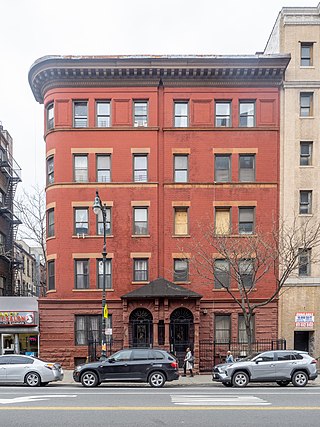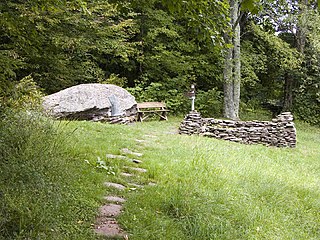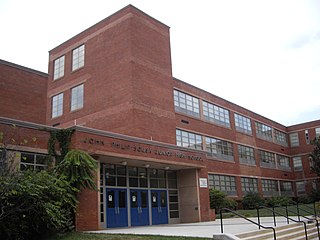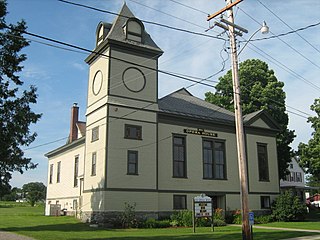
Flower Hill is a village in Nassau County, on the North Shore of Long Island, in New York, United States. The eastern half is considered part of the Greater Roslyn area, which is anchored by the Incorporated Village of Roslyn. Western and northern parts are more closely associated with Manhasset and Port Washington. The population was 4,794 at the 2020 census.

North Hempstead is one of three towns in Nassau County, on Long Island, in New York, United States. The population was 237,639 at the 2020 census.

Sands Point is a village located at the tip of the Cow Neck Peninsula in the Town of North Hempstead, in Nassau County, on the North Shore of Long Island, in New York, United States. It is considered part of the Greater Port Washington area, which is anchored by Port Washington. The population was 2,675 at the 2010 census.

The Fillmore House, or Millard Fillmore House, is a historic house museum at 24 Shearer Avenue in East Aurora in Erie County, New York. Built in 1826, it was from then until 1830 the residence of the 13th president of the United States, Millard Fillmore. Moved twice and significantly altered, it is the only surviving building other than the White House associated with Fillmore's life. It was designated a National Historic Landmark in 1974. The house is owned by the Aurora Historical Society and has been decorated with period furnishings. As of 2022, it is open for tours by reservation only.

The Elkanah Watson House is a historic house at Lake and South Streets in Port Kent, New York. Built in 1828, it was the home of Elkanah Watson (1758-1842), a businessman and diplomat best known for founding and promoting the idea of agricultural fairs. This house, still a private residence, was his home until his death. It was designated a National Historic Landmark in 1964.

The James Weldon Johnson Residence is a historic apartment house located at 187 West 135th Street, Harlem, Manhattan, New York City, New York. It is here where James Weldon Johnson (1871-1938) lived from 1925 until his death. In addition to being a composer, songwriter, and author, he was an outspoken advocate for civil rights, working in various roles at the NAACP, including as its General Secretary during his residency here. The building was declared a National Historic Landmark in 1976.

The Duke Ellington House is a historic residence at 935 St. Nicholas Avenue, in Manhattan, New York City. Apartment 4A in this apartment house was the home of Duke Ellington (1899-1974), the noted African American composer and jazz pianist, from 1939 through 1961. It was listed on the National Register of Historic Places as a National Historic Landmark in 1976.

Woodchuck Lodge is a historic house on Burroughs Memorial Road in a remote part of the western Catskills in Roxbury, New York. Built in the mid-19th century, it was the last home of naturalist and writer John Burroughs (1837-1921) from 1908, and is the place of his burial. The property is now managed by the state of New York as the John Burroughs Memorial State Historic Site, and the house is open for tours on weekends between May and October. The property is a National Historic Landmark, designated in 1962 for its association with Burroughs, one of the most important nature writers of the late 19th and early 20th centuries.

The Jackie Robinson House is a historic house at 5224 Tilden Avenue in the Brooklyn borough of New York City. Built c. 1912-1916, it is prominent as the home of baseball great Jackie Robinson from 1947, when he was awarded Rookie of the Year, through 1949, when he was voted Most Valuable Player. It was declared a National Historic Landmark in 1976.

Lyman Trumbull House is a house significant for its association with former U.S. Senator from Illinois Lyman Trumbull. The house is located in the historic Middletown neighborhood in Alton, Illinois. Senator Trumbull was best known for being a co-author of the Thirteenth Amendment to the United States Constitution.

The Hill–Physick–Keith House, also known as the Hill–Keith–Physick House, the Hill–Physick House, or simply the Physick House, is a historic house museum located at 321 S. 4th Street in the Society Hill neighborhood of Philadelphia, Pennsylvania, USA. Built 1786, it was the home of Philip Syng Physick (1768–1837), who has been called "the father of American surgery". The house was declared a National Historic Landmark in 1976. It is now owned and operated by the Philadelphia Society for the Preservation of Landmarks as a house museum.

Carter Glass House is a historic house at 605 Clay Street in Lynchburg, Virginia. Built in 1827, it is nationally significant as the longtime home of United States Congressman, Senator, and Treasury Secretary Carter Glass (1858-1946), who championed creation of the Federal Reserve System and passage of the Glass-Steagall Act, which constrained banking activities. The house was designated a National Historic Landmark in 1976. It now serves as a parish hall for the adjacent St. Paul's Church.

Prestwould is a historic house near Clarksville, Virginia. It is the most intact and best documented plantation surviving in Southside Virginia. The house was built by Sir Peyton Skipwith, 7th Baronet Skipwith, who moved his family from his Elm Hill Plantation to Prestwould in 1797. It was declared a National Historic Landmark in 2003. It is located on the north side of the Roanoke River, 1-mile (1.6 km) inland, approximately 6 miles (9.7 km) southwest of the intersection of Route 15 and Route 701, and approximately one mile north of Clarksville's town limits. Now a museum property, it is open for tours from April to October, or by appointment.

Spence's Point is a historic estate on the Potomac River near Westmoreland, Virginia. Also known as the John R. Dos Passos Farm, it was the home of writer John Dos Passos (1896–1970) for the last 25 years of his life. It was declared a National Historic Landmark in 1971.

The John Philip Sousa Middle School, formerly the John Philip Sousa Junior High School, is a public school located at 3650 Ely Place in SE area of Washington, D.C. Located in the city's Fort Dupont neighborhood, it serves grades 6–8. Its school building, built in 1950, was the scene of civil rights action not long after its construction. Twelve black students were denied admission to the all-white school. This action was eventually overturned in the landmark 1954 Supreme Court decision in Bolling v. Sharpe, which made segregated public schools illegal in the District of Columbia. The defeat of the legal doctrine "separate but equal" marked an early victory in the modern Civil Rights Movement.
Daniel Coit Gilman Summer House, also known as Over Edge, is a historic house on Huntington Lane, a private road off Huntington Road in Northeast Harbor, Maine. It was designated a National Historic Landmark in 1965 for its association with Daniel Coit Gilman (1831–1908), the president of Johns Hopkins University and a leading advocate of graduate education in the United States. The house is still used as a private summer residence.

The Sam Rayburn House Museum is a historic house museum at 890 West Texas State Highway 56 in Bonham, Fannin, Texas. Built in 1916, it was home to Sam Rayburn (1882-1961), a famously effective Speaker of the United States House of Representatives. It was declared a National Historic Landmark in 1976. Since 1972, it has been operated as a museum and state historic site by the Texas Historical Commission.

The Sands-Willets Homestead is a historic house and museum located within the Incorporated Village of Flower Hill in Nassau County, on Long Island, in New York, United States.

The Enosburg Opera House is a historic performance venue and meeting space at 123 Depot Street in Enosburg Falls, Vermont. Built in 1892 by the B.J. Kendall Company, a prominent local employer, it has been used since then as a regionally prominent performance venue. It also serves as the site of Enosburg's town meetings. It was listed on the National Register of Historic Places in 1978.

Strathmore is an unincorporated, Levitt & Sons-developed hamlet in the Town of North Hempstead in Nassau County, on the North Shore of Long Island, in New York, United States, within the census-designated place (CDP) of Manhasset.
























